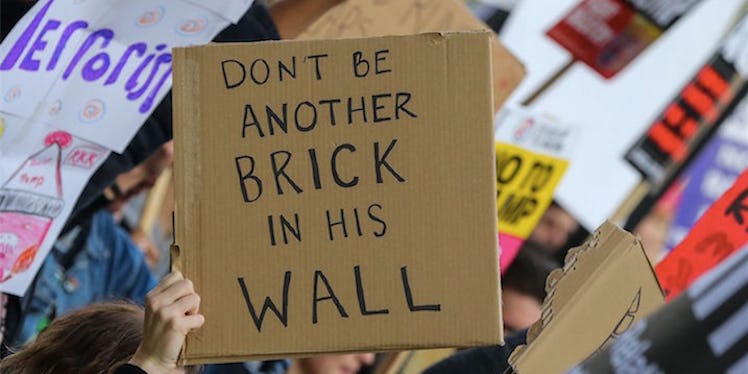
7 Things You Need To Know About ICE, Trump's 'Deportation Force'
It's been about a month under the Trump administration, and already, the nation has been inundated with attacks on the marginalized.
Donald Trump's executive orders gave the go ahead on the Dakota Access and Keystone pipelines a month after Obama decommissioned it, banned US-backed foreign organizations from offering abortion counseling and threatened to remove federal funding from sanctuary cities.
But with all of these executive orders came a wave of dissent, as well as some instances of civil disobedience that garnered the attention of news media outlets around the country.
However, while the public was focusing on some of the more obvious encroachments on civil liberties, something a bit more insidious was taking place behind the scenes.
It's a known fact that one of President Trump's biggest concerns is immigration from Mexico. While statistics do not support his fears, he has nonetheless taken most of the necessary steps to ensure "bad hombres" are forced out of this country, by way of ICE.
But does anyone even know what ICE is? We break down everything you need to stay informed.
1. What does ICE stand for?
ICE stands for Immigration and Customs Enforcement. It is an extension of the US Department of Homeland Security, and it started under the Bush administration after the September 11 attacks.
Its main purpose is to enforce any of the 400 statutes set forth by the federal government regarding deportation, protection against terrorists and the fight against the illegal transportation of illegal people and goods, according to the agency's official website, ice.gov.
2. What is the silent executive order?
On January 25, President Trump signed two executive orders into effect. One called for the strengthening of ICE, while the other called for a border wall that would be paid for by Mexico.
Granted, both those orders did get people talking... just not for long. They were dwarfed by the executive order signed two days later that banned the entry of Muslims from particular countries that are "high risk" for terrorism.
3. Who is being targeted?
So, why is strengthening an organization charged with protecting Americans bad? Inherently, it's not.
Just like the stop-and-frisk campaign from the '90s, the intentions are to protect the public from criminals and people who wish the public harm.
However, if you must selectively target and stereotype in order to protect the public, it becomes an issue of racism. And it became a huge topic of debate during the 2016 presidential election because in order to be as thorough as Trump pledges to be, Tim Kaine said officers would have to go "house to house, school to school, business to business and kick out 16 million people."
But what they're actually doing is worse.
Last week in El Paso, Texas, an undocumented woman was met outside of a courthouse by six ICE agents... right after receiving a protective order for domestic abuse. And although she had been deported before, this action by ICE serves to urge undocumented people to stop reporting acts of violence against them, for fear of being targeted.
4. Where are people being targeted?
The Department of Homeland Security estimated around 700 arrests were made during the first campaign of raids under President Trump. But it's also important to know a quarter of those arrested were not known criminals.
And with the president attacking sanctuary cities, there is the increasing fear nowhere will be safe.
Miami-Dade County in Florida was one of the first major sanctuary cities to crack under pressure, but most of the focus has been on "target-rich" areas in Texas.
5. Does it work?
The short answer is no.
For one, the estimated cost of Trump's full immigration plan – meaning deporting all illegal immigrants in the country – is between $200 to $400 billion, according to Business Insider. The publication also calculated the 11 million immigrants here also contribute around $15 billion to social security.
So, all that money? Gone.
Secondly, incarcerating the illegal immigrants cost American taxpayers $1.87 billion in 2014, according to the National Review. So, imagine how quickly taxes will raise if that's all our government is focusing on.
Of course, this has all been calculated without the cost of that infamous wall.
Historically, America has had a hard time with immigrants, with the first immigrants destroying the Native American race. Then, around 600 years later, the influx of Japanese immigration and indiscriminate fear of the Japanese people caused the US to start Japanese Internment camps.
Mexicans are simply the latest victims of this prejudiced fear.
6. What will it take to stop this from happening?
It's going to take public upheaval. It's going to take civil disobedience. It's going to take citizen participation in politics.
It's going to take a reasonable Congress: one with people in it who believe in the rights of human beings, no matter where they come from.
The problem is, detailed media coverage needs to be on high alert on this issue. Donald Trump's team is also doing a poor job of publicly announcing these laws, causing many Americans to be misinformed on the issue.
7. What can you do?
Call your senators. Vote during the midterms in 2018.
Donate to the National Immigration Law Center, the American Civil Liberties Union, Border Angels, National Immigration Forum and Mexican American Legal Defense and Education Fund.
Write about it. Spread the word. Educate.